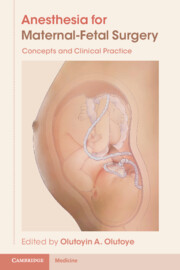Book contents
- Anesthesia for Maternal-Fetal Surgery
- Anesthesia for Maternal-Fetal Surgery
- Copyright page
- Dedication
- Contents
- Contributors
- Abbreviations
- Preface
- Acknowledgments
- Section 1
- Section 2
- Chapter 6 Twin-Twin Transfusion Syndrome
- Chapter 7 Fetal Endoscopic Tracheal Occlusion (FETO)
- Chapter 8 Fetal Cardiac Intervention
- Chapter 9 Antepartum Fetal Monitoring
- Section 3
- Index
- Endmatter
- References
Chapter 7 - Fetal Endoscopic Tracheal Occlusion (FETO)
from Section 2
Published online by Cambridge University Press: 19 November 2021
- Anesthesia for Maternal-Fetal Surgery
- Anesthesia for Maternal-Fetal Surgery
- Copyright page
- Dedication
- Contents
- Contributors
- Abbreviations
- Preface
- Acknowledgments
- Section 1
- Section 2
- Chapter 6 Twin-Twin Transfusion Syndrome
- Chapter 7 Fetal Endoscopic Tracheal Occlusion (FETO)
- Chapter 8 Fetal Cardiac Intervention
- Chapter 9 Antepartum Fetal Monitoring
- Section 3
- Index
- Endmatter
- References
Summary
Despite advances in neonatal and surgical care, the outcome of severe congenital diaphragmatic hernia (CDH) is still quite poor. Improvements in the ability to diagnose and risk stratify CDH prenatally have led to investigations into whether the more severe forms of CDH may benefit from in-utero intervention to ameliorate the accompanying pulmonary hypoplasia. Fetal endoscopic tracheal occlusion (FETO) is an example of a prenatal surgical intervention that was made possible by the technological advancements in endoscopic surgery. FETO is generally performed in fetuses with more severe forms of CDH to stimulate prenatal lung growth. While FETO is still considered investigational therapy and has not attained standard of care status, the results from published data to date have been promising. The complexity of FETO, coupled with the surgical and anesthetic risk to the mother and fetus requires a highly functional multidisciplinary fetal team, which includes obstetrics, pediatric surgery, and anesthesiology. This chapter will provide an in-depth understanding of the history of fetal endoscopic tracheal occlusion for CDH, the operative and anesthetic approach to FETO and associated perioperative considerations. Congenital diaphragmatic hernia continues to be a disease that perplexes obstetricians, neonatologists, surgeons, anesthesiologists, and the entire care team.
Keywords
- Type
- Chapter
- Information
- Anesthesia for Maternal-Fetal SurgeryConcepts and Clinical Practice, pp. 95 - 102Publisher: Cambridge University PressPrint publication year: 2021



